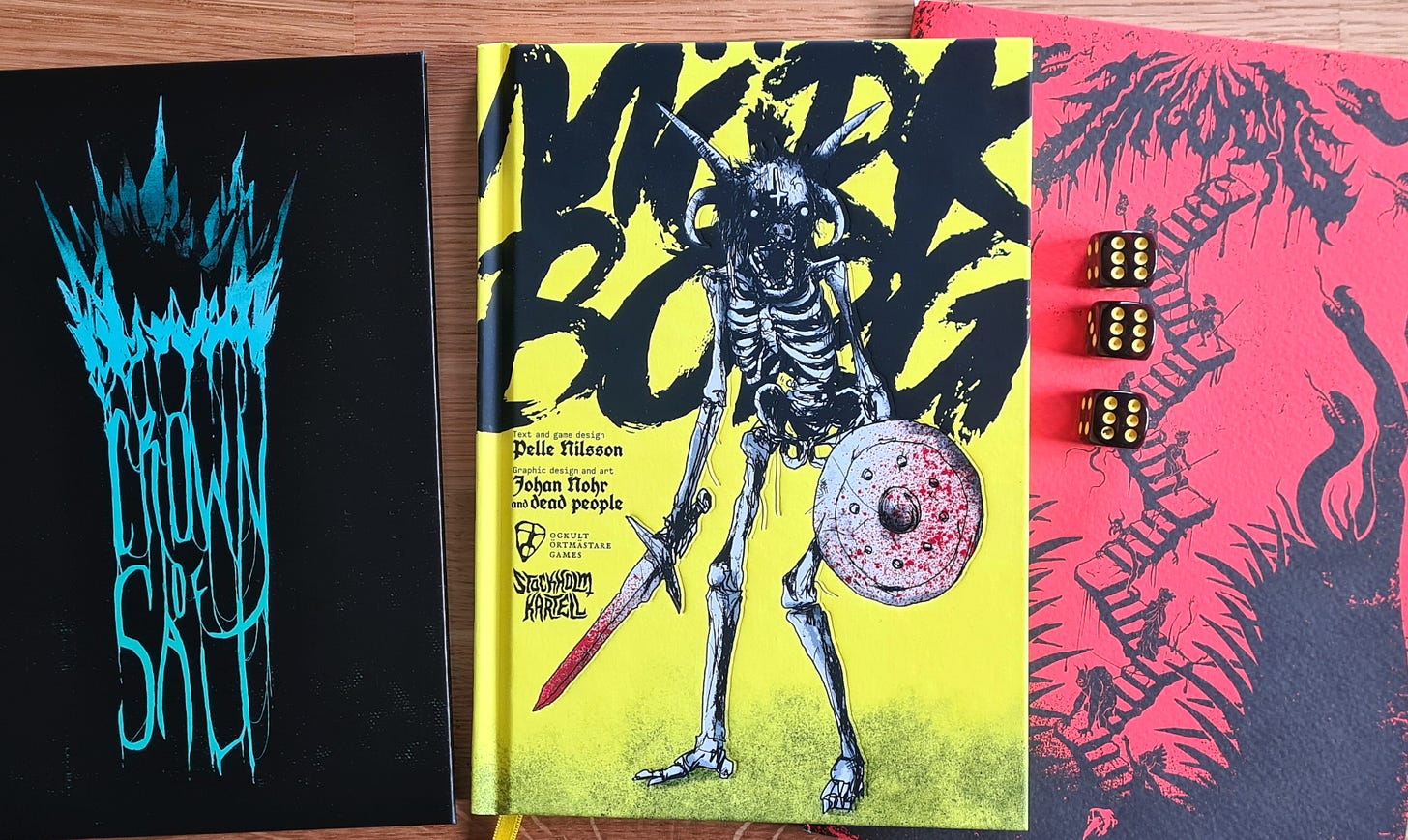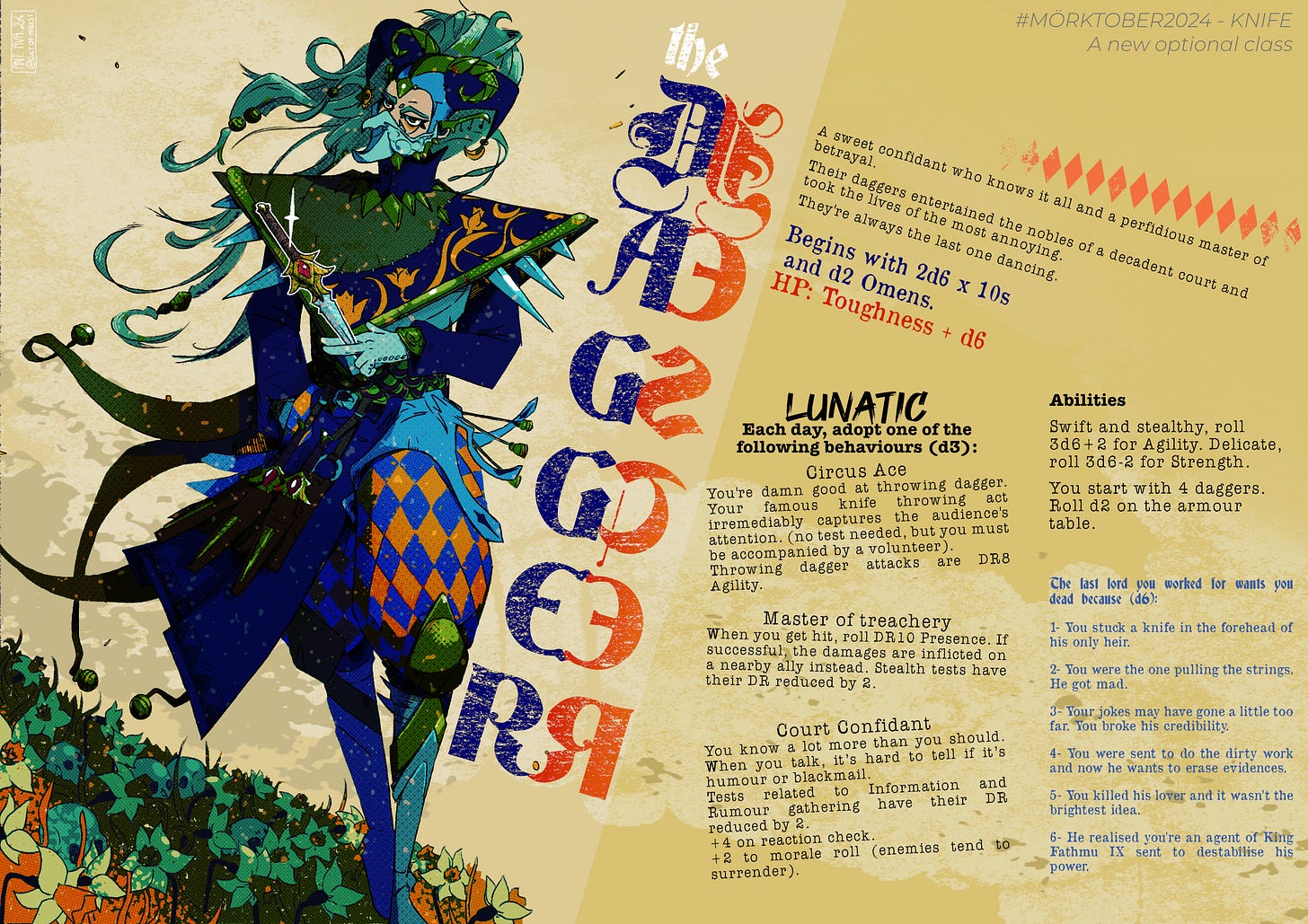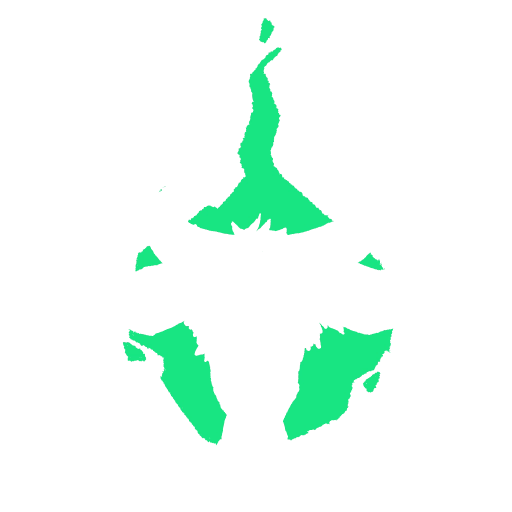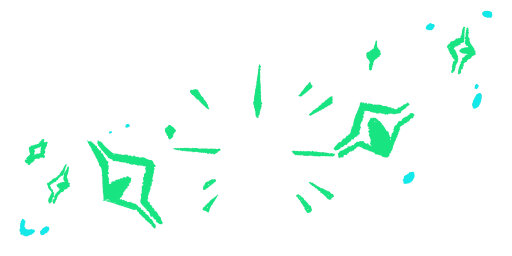Extraction #3 - Mörk Borg
7/29/2025
Oy fellow cultist! Welcome to the 3rd entry of my series Extraction. I choose a game I like and extract 5 mechanics from it. Sometimes, it’s core mechanics, sometimes gameplays details and really specific systems. The goal: create a repertoire of features that can serve as a reference for new projects.
Last time, we zoomed on Shadowdark (read the article here). Today, make room for the game with the most recognizable graphic style around here, Mörk Borg!

Summary: Mörk Borg
Published in 2020 (find it here), Mörk Borg is a game born from the fruitful collaboration between Pelle Nilsson (writing and game-design) and Johan Norh (art). Mr. Nohr brings that very particular, so Metal style, which has become an institution in the world of TTRPGs. And, undeniably, as the game's synopsis likes to remind us, the atmosphere of Mörk Borg is a piece of Doom Metal. Dark, brutal, heavy.
A deliquescent world, hopeless. Cults, dark and macabre, mad kings, illness and death. A sick graphic design, slick artworks and a mastery of the use of stock art. Each page, a masterpiece of composition.
It's a highly narrative game, and many of its systems are primarily plot devices, offering players opportunities to fuel their imagination.
From a mechanical standpoint, there are 4 stats that directly modify dice rolls. Roll over, variable difficulty cap (DC), etc. A very simple, straightforward mechanical approach.
In this very balanced mix between rules and storytelling, I chose 5 mechanics which illustrate the strength of this game and which are examples to use in other projects.
Table of contents:
-
The Calendar of Nechrubel
-
Optional Classes
-
Followers with randomized traits
-
Finding on Monsters
-
Omens
1) The calendar of Nechrubel
At the core of the global gameplay loop, a calendar, an hybrid mechanic between narration and game rules.
The calendar is basically a D66 tables. Each entry is a new calamity, an event occurring in the game world, bringing new perils to the players and material for improvisation for the GM. In short, it's an additional hook to drive the campaign's story.
Each day at dawn, the group rolls a die. The type of die to be used depends on the length of the players' planned campaign. For a campaign that would last a year, use a D20; for a month, a D6. On a 1, a new calamity is selected from Nechrubel's calendar using a d66.
Here are some calamities from the calendar:
-
1:5 Doubt is crowned. The loyal shall turn their blades on those who silver gave.
-
3:5 Then shall come rain unending and the day shall be made night by its coming
-
4:3 Look to the West. Forth comes fire, and a horde, and the Kingdoms burn.
These calamities are to be interpreted freely in-game by the GM and the players. They could be the vector for new adventures. During the 1:5, for example, the town's militia, normally loyal to the count, could one morning turn against him and seek to overthrow him. This is a new adventure for the players.
What's great about this calendar is that the heart of Mörg Bork's lore is based on the announcement of a systematically self-fulfilling prophecy, enumerated by a monk from ancient times. The calendar is placed, in the book, at the crossing between the lore and the gameplay, demonstrating the blurred line between pure game mechanics and narrative mechanics.
A good example of a system serving the settings.
Oh, and once the seventh calamity is drawn, the final calamity occurs. And marks the end of the campaign. A brutal ending, but so useful for stopping a campaign that drags on, but also for injecting that sense of imminent doom into the game!
- 7:7 […] And the darkness shall swallow the darkness.
2) Optional Classes
By default, in Mörk Borg, players have the option to create classless characters. Their stats, basic equipment, physical or mental characteristics, as well as their background are randomly drawn. I appreciate this option because it gives the player the chance to create their own story and embody a character of their choice. The game also offers a wide range of tables to draw from to design their avatar: childhood trauma, deformity, vices, etc. (a whole bunch of very enjoyable features, eh?).
At the same time, classes are optional. But like everything in this game, they bring narrative baggage to the character who chooses to embrace them. Some benefit from a special ability, drawn randomly, others from modified stats. They often balance a benefit against a penalty, like a kind of trade-off. They are no more "powerful" than classless characters.
The decadent noble, for example, might start the game with a jester follower, who can distract enemies in combat. Or he might set out on an adventure with the Sword of his Ancestors, a cursed, powerful, but treacherous weapon.
Classes are also a good way to tell the lore of the game through an interesting « Show, don't tell ». If you can play as a bloodthirsty deserter, a heretic priest or a depraved nobleman, you quickly get an idea of the atmosphere of the game. The classes offered by the core book are also quite specific, showing the GM that they have a real role to play in telling the story of the world. Here, there are no generic Warriors, Mages, or Rogue.
Interlude: Here is a class I’ve designed for #Mörktober2024 ! The Dagger Jester!

Come visit my portfolio to see more of my drawings!
3) Followers with randomized traits
Followers, Hirelings or other aide-de-camp are TTRPG classics. And Mörk Borg is no exception. But I wouldn’t have chosen this mechanic if the game didn’t offer some interesting twists.
First of all, it's clear that the followers offered by the game are strange: half-man, half-dog savages, lantern-headed humanoids, and others.
The mechanic that I particularly like is that their characteristics and their specialty are to be drawn at random, varying the usefulness that they can bring to the group.
The lantern-headed creatures, the Wild Wickheads, can provide light for the group or become assassins, specializing in knife-wielding skills. The Prowlers, nothing less than outlaw thugs, can serve as guides or thieves for the team.
The methods used to maintain their loyalty also vary. Payment in money, listening to depressing stories, drinking wine... A whole host of little stories fleshing out the followers.
I find it amusing that even mechanics like followers are influenced by the overall atmosphere of the game.
4) Findings on monsters
You've just taken down a troll. It was a hell of a fight, and Hermul ate the ground. But it was worth it. You remember a trader who was looking for troll horns and was willing to pay a nice sum of silver.
In Mörk Borg's bestiary, each monster can yield a tidy sum depending on the parts sold or the creature's condition. This is specific to each creature and therefore adds a bit of lore.
For example:
-
A captured troll is worth about 200 silvers.
-
Dead troll is worth 70 silvers.
-
Each of its horns is worth 20 silvers.
Convenient for rewarding the players after a tough fight, or to keep them engaged with the game world. Which could mean interacting with NPCs, organizing and making decisions. Here, even a skeleton could be interesting for the characters.
We can also notice that captured monsters are systematically worth a higher value than their … well, dead counterpart. I see this as a good way to encourage players to find alternatives to mindless, vicious slaughter
The merchant, after taking a quick glance at the quality of the horns, hands them to a middle-aged man sitting at a workbench at the back of the shop. In addition to a modest purse of several silvers, he also gives you a small vial filled with ivory-colored powder. “We still had a little left over. Here, it's for you. ‘works well against goblin plague infection.”
5) Omens
We're all familiar with D&D Luck Tokens. These tokens, distributed at the GM's discretion, allow players to reroll one of their dice rolls in the hope of achieving a better result. This is an interesting tool because it allows players to have a slight impact on the fate and unfolding of the narrative. However, as a GM, I rarely use them, as I find rewarding one player over another a bit arbitrary and awkward.
Mörk Borg offers its own version of the Luck Token, the Omen, and I find it much more intelligent.
Each character has a variable number of Omen (usually 1d2 or 1d4, depending on the class). These Omens, once spent, can be regained after a long rest.
When used, they allow:
-
deal maximum damage with an attack.
-
Reroll a dice roll, for any player
-
Lower damage dealt to the character by 1d6
-
Neutralize a crit or a fumble
-
Lower the difficulty of a dice check (by 4)
Omens are a real narrative tool at the players' disposal. Easy to regain, they compensate for the deadliness of the game and offer players the possibility of changing the course of events in their direction. Their use is versatile, the range of actions they can influence is wide. I also appreciate the non-arbitrary aspect of the distribution (regained after a long rest), removing a burden from the GM's shoulders and avoiding a potential feeling of injustice among the players.
Again, this is just a selection of five mechanics among many others in the game. While the vanilla game is already very interesting, it's the plethora of supplements, adventures, hacks, and more, created by fans, that really make the Mörk Borg universe shine. Pirate Borg, Solo Borg, adventures like Crown of Salt… I've rarely seen a game that so stimulated the imagination of artists and other budding creators (just look at the content page of the official website!). Mörk Borg paved the way for an ultra-trashy and metal universe, and it's so good!
What if for the next article, I changed the mood completely. Dungeons and Kittens, anyone?
Have a great day! The Cult of Magest is watching ☀️



